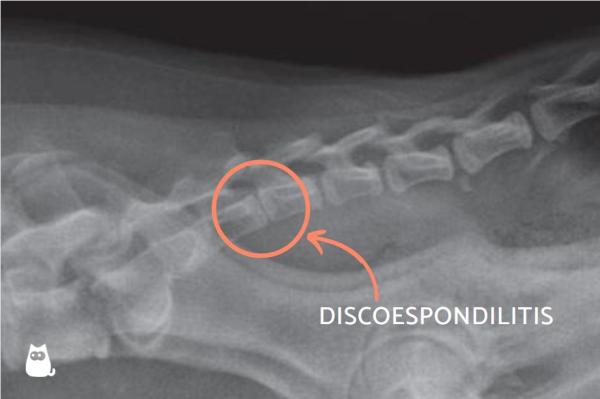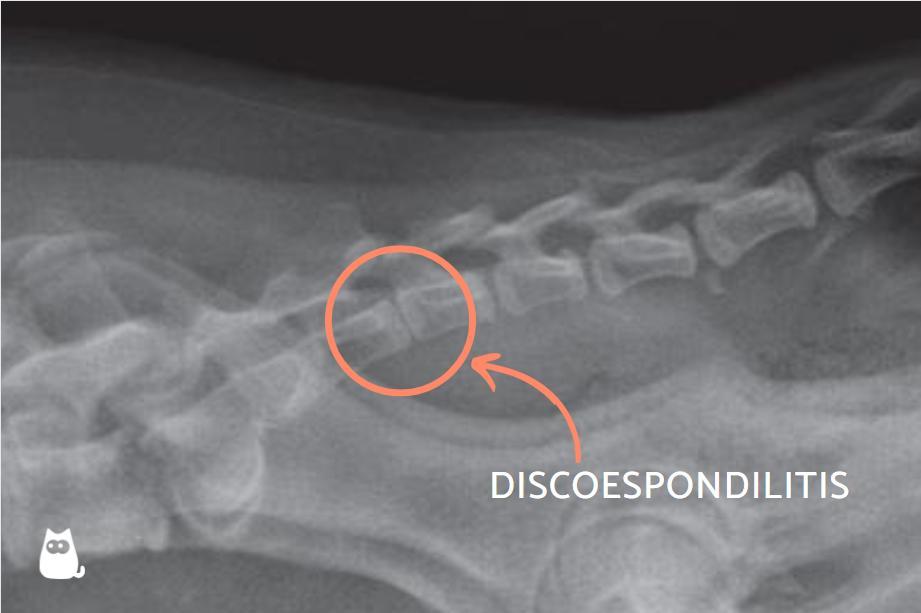Discospondylitis in Dogs - Symptoms and Treatment



See files for Dogs
Canine discospondylitis is a spinal disease consisting of an infection of the intervertebral disk and associated vertebrae, which may occur in more than one location of our dogs' spine. Most often, the disease is caused by bacteria, but it can also be caused by fungi. Diagnosis is usually made using imaging techniques such as x-rays, CT and magnetic resonance imaging, along with cultures or punctures to search for the causative agent. Treatment depends on the severity of the disease and may be medicinal or surgical.
The following AnimalWised article explains what canine discospondylitis is, its causes, symptoms, how it is diagnosed and how it is treated.
What is discospondylitis in dogs?
Discospondylitis is an inflammation of the spine caused by infection of the disk and adjacent vertebrae. Usually bacteria or fungi cause the infection. Discospondylitis in dogs typically begins in the vertebral endplate and then spreads to the adjacent disk.
It is a spinal disease that is much more common in dogs than in cats. It occurs mainly in young to middle-aged, male, purebred, unneutered, medium to large dogs. Likewise, it is much less common in small breed or chondrodystrophic dogs.
Deforming spondylosis or parrot beaks in the spine of dogs should not be confused with discospondylitis, as they are sometimes referred to as the same thing.
Continue reading this other article to learn more about spondylosis in dogs.
Symptoms of discospondylitis in dogs
Symptoms of canine discospondylitis vary depending on the degree of the infection. In general, affected dogs show the following symptoms:
- Back pain
- Difficulty moving
- Muscle weakness in the limbs
- Depression
- Fever
- Loss of appetite and weight
In addition, clinical signs of musculoskeletal dysfunction are common, such as fatigue, ataxia, hyperesthesia, or even difficulty walking. In severe cases, a dog may become paralyzed.
Finally, neurologic signs may also occur, including extradural compression and paresis or paralysis. These signs can vary depending on the affected vertebral site and the severity of the infection. Occasionally, meningitis or meningoencephalitis may occur if the infection spreads to the central nervous system.

Causes of discospondylitis in dogs
Discospondylitis occurs when bacteria or fungi reach the intervertebral disks. In this sense, the most common route of infection is the hematogenous spread of microorganisms from one focus of infection to another part of the body. This can be the skin, genitourinary tract, oral cavity, respiratory tract, and heart valves. Keep in mind that intervertebral disk space has a high blood flow, which can allow bacteria and fungi to accumulate, easily leading to infection in this area.
It can also be caused by penetration of foreign bodies of plant origin, such as spines, spinal injuries, bites, puncture wounds, and osteomyelitis in other bones. These foreign bodies can enter the body by inhalation, ingestion, or through a penetrating wound. If they contain bacterial or fungal contaminants, discospondylitis may result.
The bacteria that usually cause this disease are:
- Staphylococcus intermedius
- Streptococcus
- Brucella canis
- Escherichia coli
Certain fungi can also cause discospondylitis in dogs, such as:
- Aspergillus
- Coccidioides immitis
- Paecilomyces
If you want to learn more about fungal infections in dogs, continue reading this other article, where we discuss the most common fungal infections in dogs, as well as their treatment and diagnosis.
Diagnosis of discospondylitis in dogs
First, a thorough clinical history and physical examination are performed on the dog to make the diagnosis. This includes ancillary investigations such as blood tests, urine, and blood cultures to detect the microorganism.
This Discospondylit is most effectively diagnosed by imaging tests, including x-rays, myelography, CT scans, and magnetic resonance imaging. In order to diagnose this disease, radiographs of the dog's entire spine are required.
In the results of imaging studies, the veterinarian may find: collapsed disk spaces, erosion of the lamina terminalis, and focal laminae lysis. Proliferative changes in the bones adjacent to the disk space and sclerosis at the margins of bone loss are also seen.
A CT scan can be very helpful for early diagnosis and in cases where the radiograph does not show discospondylitis lesions. It can be performed in combination with myelography to detect possible spinal cord compression.
Magnetic resonance imaging is the most sensitive test for evaluating the disk, spinal cord, vertebrae, and paravertebral muscles. It also identifies changes in the bone marrow of the vertebrae that occur in the early stages of the disease and precede osteolytic lesions.

Treatment for discospondylitis in dogs
Discospondylitis in dogs can be treated with medication or surgery, depending on the case.
Medication
Medical treatment consists in the application of specific antibiotics to the pathogen for a certain time, among which the following stand out:
- First generation cephalosporins
- Clindamycin
- Trimethoprim
Treatment is usually continued for a period of 6-12 months, with long courses of medication required to clear the infection. Discontinuing the medication too soon may cause the signs of discospondylitis to reappear, even in a dog that has shown dramatic signs of improvement.
Generally, symptoms improve in dogs within a few days, especially fever and spinal hyperesthesia; neurologic signs often take a little longer to resolve. On the other hand, anti-inflammatory drugs such as NSAIDs and analgesics are usually administered.
Surgery
It is recommended that dogs with extradural spinal cord compression and significant neurologic deficits undergo surgical treatment if they fail to respond to antibiotics or have negative cultures.
Depending on the location of the lesion, decompressive techniques such as ventral slit, hemilaminectomy, or dorsal laminectomy may also be included in treatment. If the intervertebral spondylitis is secondary to brucellosis, although this is rare, the affected dog should also be sterilized.
In addition to these targeted treatments, treatment for discospondylitis usually includes pain medications. There are a number of pain medications that can be used depending on the level of pain and overall health of your dog.
Life expectancy of a dog with discospondylitis
There is no short answer to this question. In general, canine discospondylitis has a good prognosis, but it depends on the severity, timing, and effectiveness of treatment.
Dogs with mild symptoms, such as spinal pain with mild neurologic deficits, and those that respond well to medical treatment have a good prognosis. If a fungal infection, fracture, subluxation, or endocarditis is present, the prognosis is guarded. While most dogs do respond to medication, some do not.
It is not possible to cure Brucellosis infection completely, but long-term antibiotics are often effective in treating it and your dog can have a good quality of life.
If your dog shows any of the symptoms of discoespindylitis described above, you should see a veterinarian as soon as possible.
This other article examines canine anatomy and categorizes the muscles, bones, and organs of dogs in detail.
This article is purely informative. AnimalWised does not have the authority to prescribe any veterinary treatment or create a diagnosis. We invite you to take your pet to the veterinarian if they are suffering from any condition or pain.
If you want to read similar articles to Discospondylitis in Dogs - Symptoms and Treatment, we recommend you visit our Bacterial diseases category.
- Martín, P. An approach to discospondylitis. Available at: https://www.imveterinaria.es/uploads/2018/06/aproximacion_discoespondilitis_1840_20180621110928.pdf
- Imavet. Discospondylitis. Available at: https://www.imavet.es/archivos/articulos/3627168285d1c86530cb3c6.47106226.pdf







